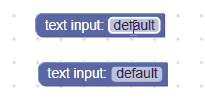ช่องป้อนข้อความจะจัดเก็บสตริงเป็นค่าและสตริงเป็นข้อความ ค่าของแอตทริบิวต์นี้จะเป็นสตริงที่ถูกต้องเสมอ ส่วนข้อความอาจเป็นสตริงใดก็ได้ที่ป้อนลงใน เอดิเตอร์ของแอตทริบิวต์
ช่องป้อนข้อความ

ช่องป้อนข้อความพร้อมเปิดเครื่องมือแก้ไข

ฟิลด์ป้อนข้อความในบล็อกที่ยุบ

การสร้างวิดีโอ
JSON
{
"type": "example_textinput",
"message0": "text input: %1",
"args0": [
{
"type": "field_input",
"name": "FIELDNAME",
"text": "default text",
"spellcheck": false
}
]
}
JavaScript
Blockly.Blocks['example_textinput'] = {
init: function() {
this.appendDummyInput()
.appendField("text input:")
.appendField(new Blockly.FieldTextInput('default text'),
'FIELDNAME');
}
};
ตัวสร้างอินพุตข้อความจะรับค่าที่ไม่บังคับและเครื่องมือตรวจสอบที่ไม่บังคับ ค่าควรส่งไปยังสตริง หากเป็น null หรือ undefined ระบบจะใช้สตริงว่าง
คำจำกัดความของ JSON ยังช่วยให้คุณตั้งค่าตัวเลือกการตรวจตัวสะกดได้ด้วย
การซีเรียลไลซ์และ XML
JSON
JSON สำหรับช่องป้อนข้อความมีลักษณะดังนี้
{
"fields": {
"FIELDNAME": "text"
}
}
โดย FIELDNAME คือสตริงที่อ้างอิงช่องป้อนข้อความ และ
ค่าคือค่าที่จะใช้กับช่อง ค่า
เป็นไปตามกฎเดียวกันกับค่าของตัวสร้าง
XML
XML สำหรับช่องป้อนข้อความมีลักษณะดังนี้
<field name="FIELDNAME">text</field>
โดยที่แอตทริบิวต์ name ของฟิลด์มีสตริงที่อ้างอิงฟิลด์ป้อนข้อความ
และข้อความด้านในคือค่าที่จะใช้กับฟิลด์ ค่าข้อความด้านใน
จะเป็นไปตามกฎเดียวกันกับค่าของตัวสร้าง
การปรับแต่ง
ตรวจตัวสะกด
ฟังก์ชัน
setSpellcheck
ใช้เพื่อตั้งค่าว่าฟิลด์จะตรวจตัวสะกดของข้อความที่ป้อนหรือไม่
ฟิลด์ป้อนข้อความที่มีและไม่มีการสะกดคำ

การตรวจตัวสะกดจะเปิดอยู่โดยค่าเริ่มต้น
ซึ่งจะมีผลกับแต่ละฟิลด์ หากต้องการแก้ไขช่องทั้งหมด ให้เปลี่ยนพร็อพเพอร์ตี้
Blockly.FieldTextInput.prototype.spellcheck_
การสร้างเครื่องมือตรวจสอบอินพุตข้อความ
ค่าของช่องป้อนข้อความเป็นสตริง ดังนั้นเครื่องมือตรวจสอบใดๆ ต้องยอมรับสตริง
และแสดงผลสตริง null หรือ undefined
ตัวอย่างโปรแกรมตรวจสอบที่นำอักขระ a ทั้งหมดออกจากสตริงมีดังนี้
function(newValue) {
return newValue.replace(/a/g, '');
}


